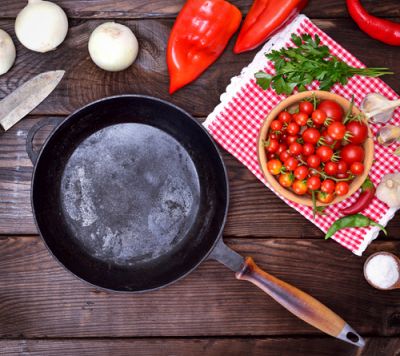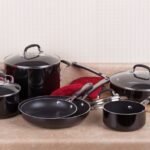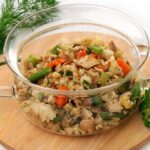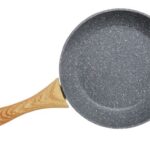The cast-iron cookware is highly prized for its remarkable advantages such as excellent heat retention and steady cooking. It keeps food warm for longer periods than any other cookware. Cast iron is a very tough and durable material that will last a lifetime. Some cookware pieces can last for generations. It is also extremely versatile and can be used for cooking a wide range of foods. You can use it on a variety of cooking surfaces including an open flame.
However, due to the density of the material, traditional cast iron cookware pieces are quite heavy. Transferring a cast iron skillet full of food from the stove to the table can sprain your wrist.
What is Lightweight Cast Iron Cookware?
The lightweight cast iron cookware has entered the market in recent years. This cookware offers some benefits of regular cast iron, but it is not as heavy as traditional cast iron. Being up to 50 percent lighter than standard cast iron, this cookware is much easier to pick up, use, and clean. The pans often have a riveted stainless-steel handle for easy handling.

Lightweight cast iron cookware can be used on all heat sources and is suitable for cooking a wide range of meals.
The common lightweight cast iron cookware items include frying pans, woks, skillets, griddles, and Dutch ovens.
Lightweight Cast Iron Cookware vs. Standard Cast Iron Pieces
- More comfortable weight is the main advantage of light cast iron cookware over traditional ones. It is said that cast iron becomes heavier as the owner grows older. The lighter cookware items are easier to handle during cooking or cleaning compared to regular cast iron. The lower weight is especially important for cookware pieces that are meant for everyday use. Being much lighter than traditional cast iron it is suitable for people with arthritis who cannot handle heavy cookware items.
- The lightweight cast iron cookware is suitable for cooking methods that require quick movements and good manageability of the pan on the stovetop such as stir-frying. Because of their heavyweight and very hot handles, traditional cast iron pans are not the perfect choice for cooking the ingredients that need to be stirred quickly. Lightweight cast iron items have wooden or riveted stainless-steel handles for better grip and mobility. A Stainless steel handle doesn’t conduct heat well and cools down much faster than a cast iron handle, which helps reduce the risk of burns.
- The light cast iron doesn’t require maximum heat. It heats up quickly and has a better thermal response than heavy cast iron cookware pieces.
Drawbacks
- The heat retention capability of cast iron cookware is proportional to its weight. A lightweight cast iron pan won’t hold heat as long as a thicker one.
- Due to lower heat retention capability, lightweight cast-iron pans cook less evenly than their thicker counterparts.
- Lightweight cast iron cookware is more fragile than traditional cast iron cookware. It is prone to damage such as cracking and splitting.
How to Care for Lightweight Cast Iron Pans
Cleaning: To treat lightweight cast iron pans, you just need to follow the same cleaning and storage directions that apply to the standard cast iron items. Cast iron cookware is not dishwasher safe. Using detergents is also not recommended because harsh detergents will ruin the seasoning and dry out the cooking surface. A mild soap can be used if you plan to re-season the pan after washing. Scrub the remaining food with a metal spatula, then rinse with pure hot water. Don’t leave it to air dry. You must dry it immediately using a paper towel, then put it on the hot stove to complete drying. Coat the inside surface with a thin layer of vegetable oil before storing it. Store it in a dry place.
Seasoning: Seasoning helps prevent rusting and makes the interior metal surface smooth. You can season lightweight cast iron items the same way as your heavy cast iron pans. Use a paper towel to rub a little flaxseed oil over the entire interior surface. Place the pan on the stovetop over medium heat or bake in the oven at 400 degrees for about an hour. Let the pan cool down and wipe with a dry paper towel.
With regular seasoning, cast iron cookware will form a smooth naturally nonstick layer over time. You need to re-season the pan occasionally by wiping the interior surface with a thin coating of vegetable oil.
Lightweight Enameled Cast Iron Cookware
This cookware has a cast iron interior and a colorful enamel exterior. The enameled exterior allows for easy cleanup and adds warm tones to the kitchen.
Some brands have an interior and exterior enamel coating. Such cookware is healthier to use for cooking purposes, as the enamel finish prevents the iron from interacting with food. These pans are easy to clean and there is no need for seasoning.
Is Light Cast Iron Cookware Worth Buying?
Customer satisfaction with light cast iron cookware products ranges from average to decent, while standard cast iron cookware items generally have a higher customer satisfaction rate.
Lightweight cast iron cookware is not meant to completely replace standard cast iron pots and pans. However, it can be an acceptable substitute for people who want to have cast iron in their kitchen but have difficulty handling traditional heavy cast iron items.
It also can be a good alternative to heavy cast iron cookware for cooking tasks that require good temperature control and agility.



